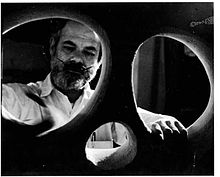Don Rubbo
| Don Rubbo | |
|---|---|
 |
|
| Born |
December 5, 1926 New Haven, Connecticut |
| Died | January 1979 (aged 52) |
| Nationality | American |
| Known for | Advertising, sculpture, painting, pop art |
Don Rubbo (December 5, 1926 – January 1979) was a mentor and guide of Peter Max and an affiliate of Andy Warhol in the mid-1960s. His philosophy of "life is art, art is life" inspired and influenced many of his students.
Admondo Dondes Rubbo was born in New Haven, Connecticut. In February 1945, at the age of eighteen, he enlisted in the army where he received three medals for his service to his country.
After the war, he settled in New York City, and in 1952 he married Maria Fontanes. They had seven children, Edmund, Linda, Donald, Robert, George, Thomas and Diana. Don and Maria divorced in 1967. He then married Cathy Palermo in 1970, and they had one child, Michael.
In 1962 Rubbo started a small Manhattan arts studio with friend Tom Daly and Daly's friend from the Art Students League of New York, Peter Max. They named it The Daly & Max Studio. Although his name was not on the business, Rubbo played a major part and the three worked as a group on books and advertising; Rubbo was known as the ampersand in "Daly & Max". In 1963, Daly, Max and Rubbo did the illustration, design and color for Helga Sandburg's (the daughter of poet Carl Sandburg) children's book Joel and the Wild Goose.
In the mid-sixties, Rubbo was hired by Dr. Robert Jastrow, founder of the Goddard Institute for Space Studies, to draw maps for NASA. At the Goddard Institute for Space Studies, he became good friends with George Goodstadt, who later went on to found Bank Street Atelier, a lithography printing studio, and George Goodstadt, Inc.
At the advertising giant Diener, Hauser, & Greenthal, Rubbo was the creative force behind the iconic images on movie posters for The Godfather (1972), The Endless Summer (1968), A Clockwork Orange (1971), and Chitty Chitty Bang Bang (1968), among others.
...
Wikipedia
